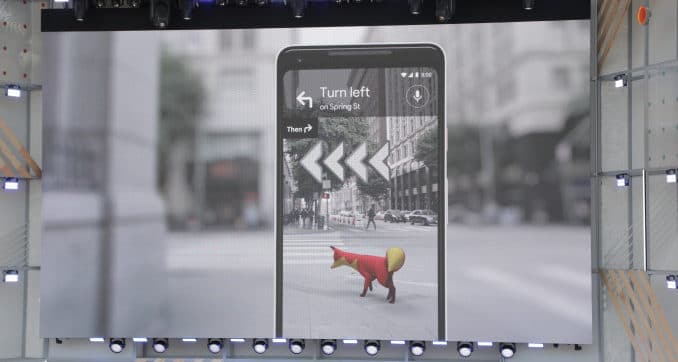
The AR Cloud’s recognition is building. Coined by Super Venture’s Ori Inbar last year, its momentum has grown through lots of press/analyst attention and startups like 6D.ai (and the topic of our latest Intelligence Briefing).
This week alone, we’ve seen a big uptick in AR cloud activity This includes a few product launches at Google I/O, a new AR Cloud startup and a spatial mapping initiative from one of AR’s first movers, Niantic. Here’s the recap of each event, and what it could mean for AR’s momentum.
First is Google’s new visual maps that offer AR wayfinding for city streets. It will do this by mapping, registering and semantically understanding scenes before overlaying directions — a key tenet of the AR Cloud. It will use Street View imagery (its own AR Cloud) for object recognition.

The World is a Big Place
But beyond Google, the AR Cloud will have to be more open and federated to support an AR app economy. Launching this week, Fantasmo claims better mapping and localization through object recognition data that it will build and supply over time, especially in untapped indoor spaces.
Like 6D.ai, this involves crowdsourced mapping to achieve scale (the world is a big place) and tools for developers to build into their apps. Speaking of crowdsourcing, Niantic indicated this week that it will launch a program that lets game players map spaces as they’re playing.
This will utilize IP from Niantic’s Escher Reality acquisition. And it will likely incentivize players through a value tradeoff. In other words, by opting to map physical spaces, you’ll be offered in-game perks or performance. Think of it like Waze’s value exchange: Collect data while using it.
Our latest intelligence briefing in fact projects something along these lines:
“This will work best with apps that have massive usage and long outdoor sessions. Pokémon Go would be well-suited to collect mapping data as users roam the physical world. There will likely be a Waze-like value exchange for opt ins, such as in-game incentives or performance.”
Anchors Aweigh
Lastly, back to Google, it announced Cloud Anchors which will enable multi-player functionality and image persistence. This is a challenging problem but is key piece of functionality for social AR, which will be a source of killer apps and overall AR growth a la network effect.
Notably, Cloud Anchors will be cross-platform and work across ARCore and ARkit, an area where YouAR has been innovating. This is important so that AR’s growth isn’t stunted by cross-platform incompatibly. Counteracting platform fragmentation will be a key industry goal this year.
Speaking of ARkit, Apple’s WWDC is in a few weeks (as is AWE) and we expect similar multi-player advancements to be announced. Beyond just persistence and multi-player, WWDC should bring more AR cloud-related announcements and advancements that join the above list.
Since Inbar coined the term last Fall, the AR cloud’s importance has been recognized but under-rated in the broader tech world. Call it the Rodney Dangerfield of XR. But that won’t be the case for long if the AR cloud’s momentum this week, and in general, is any indication.
With ARCore's Cloud Anchors, we've made it easy to build shared AR experiences. Works across Android and iOS. More here: https://t.co/mPmKzmPpcp pic.twitter.com/iafB1Rewzq
— Clay Bavor (@claybavor) May 8, 2018
For deeper XR data and intelligence, join ARtillry PRO and subscribe to the free ARtillry Weekly newsletter.
Disclosure: ARtillry has no financial stake in the companies mentioned in this post, nor received payment for its production. Disclosure and ethics policy can be seen here.
